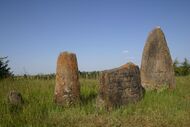Tiya (archaeological site)
Topic: Place
 From HandWiki - Reading time: 4 min
From HandWiki - Reading time: 4 min
Tiya | |
|---|---|
Archaeological site | |
 | |
| Coordinates: [ ⚑ ] : 8°26′N 38°37′E / 8.433°N 38.617°E | |
| Country | Ethiopia |
| Region | Southern Nations, Nationalities, and Peoples' Region |
| Zone | Gurage |
| Official name | Tiya |
| Type | Cultural |
| Criteria | i, iv |
| Designated | 1980 (4th session) |
| Reference no. | 12 |
| Region | Africa |
Tiya is an archaeological site in central Ethiopia. It is located in the Soddo woreda, in the Gurage Zone of the Southern Nations, Nationalities, and Peoples Region south of Addis Ababa.[1] It is best known for its archaeological site its large stone pillars, many of which bear some form of decoration. The archeological site was designated a World Heritage Site in 1980, due to the unique nature of these monolithic monuments.[1]
Overview
According to Joussaume (1995), who led archaeological work at Tiya, the site is relatively recent. It was dated to a time period between the 11th and 13th centuries CE.[2] Later dating places the stelae's construction some time between the 10th and 15th centuries CE. However, the building of megaliths in Ethiopia is a very ancient tradition, with many such monuments predating the Common Era.[3]
The menhir or stelae at the site, "32 of which are engraved with enigmatic symbols, notably swords," likely mark a large, prehistoric burial complex.[4] A German ethnographic expedition had visited the site in April 1935, and had found at one hour's journey to the south of the caravan camp the stone monoliths with sword symbol, which had been seen earlier by Neuville and Père Azaïs.[5]
Surface finds at Tiya contained a selection of Middle Stone Age tools (MSA) that are technologically similar to tools found at Gademotta and Kulkuletti. Because of a unique production process that uses what are called “tranchet blows”, Tiya tools might also belong to the same time span as these other two sites.[6] Additionally, archaeological excavations at Tiya have yielded tombs.[3]
Gurage stelae


Tiya is one of nine megalithic pillar sites in the Gurage Zone. As of 1997, 118 stelae were reported in the area. Along with the stelae in the Hadiya Zone, the structures are identified by local residents as Yegragn Dingay or "Gran's stone", in reference to Imam Ahmad ibn Ibrahim al-Ghazi (Ahmad "Gurey" or "Gran"), ruler of the Adal Sultanate.[2]
The Gurage stelae are of three types: anthropomorphic stelae with human figures, phallic stelae, and stelae of neither anthropomorphic nor phallic type. The anthropomorphic and non-anthropomorphic/non-phallic stelae types are flat in shape, being the only stelae of this form in the southern region.[2] Most of these stelae, including the 46 ones at Tiya, which are the largest of the bunch, also have distinctive, elaborate decorations.[2][3] Among these designs are swords, plant-like symbols, and a standing human figure with arms akimbo. The plant and sword emblems can be found on the same stelae.[2] The sword design is reportedly of local "Galla" type, as made by the Oromo. In addition, the Tiya rock slabs also often feature a T-shaped symbol.[7][8][9][10]
The stelae at Tiya and other areas in central Ethiopia are similar to those on the route between Djibouti City and Loyada in Djibouti. In the latter area, there are a number of anthropomorphic and phallic stelae, which are associated with graves of rectangular shape flanked by vertical slabs. The Djibouti-Loyada stelae are of uncertain age, and some of them are adorned with an analogous T-shaped emblem.[11]
Research
Little research has been done at Tiya, and there are several difficulties in understanding these types of sites from an archaeological standpoint. First, it is difficult to determine the identity of the megalith builders given just the megaliths themselves. Second, archaeologists have been preoccupied with reconstructing ethnic histories through oral historical accounts, yet these are unavailable or uninformative in many cases.[12]
See also
- Tiya (town)
References
- ↑ 1.0 1.1 "Tiya". United Nations Educational, Scientific, and Cultural Organization. https://whc.unesco.org/en/list/12.
- ↑ 2.0 2.1 2.2 2.3 2.4 Fukui, Katsuyoshi (1997). Ethiopia in broader perspective: papers of the XIIIth International Conference of Ethiopian Studies Kyoto 12-17 December 1997. Shokado Book Sellers. p. 370. ISBN 4879749761. https://books.google.com/books?id=7KpyAAAAMAAJ. Retrieved 23 December 2014.
- ↑ 3.0 3.1 3.2 "Tiya - Prehistoric site". UNESCO. https://whc.unesco.org/en/activities/159/. Retrieved 24 December 2014.
- ↑ Matt Philips and Jean-Bernard Carillet, Ethiopia and Eritrea, third edition (n.p.: Lonely Planet, 2006), p. 171
- ↑ "Local History in Ethiopia" The Nordic Africa Institute website (accessed 31 May 2008)
- ↑ Douze, Katja (2013). "A new chrono-cultural marker for the early Middle Stone Age in Ethiopia: The tranchet blow process on convergent tools from Gademotta and Kulkuletti sites". Quaternary International 343: 40–52. doi:10.1016/j.quaint.2013.10.018.
- ↑ The Eastern Anthropologist, Volume 3, Issues 1-4. Ethnographic and Folk Culture Society, U.P.. 1949. p. 121. https://books.google.com/books?id=EBcNAAAAIAAJ. Retrieved 15 January 2015.
- ↑ Mire, Sada (2020-02-05) (in en). Divine Fertility: The Continuity in Transformation of an Ideology of Sacred Kinship in Northeast Africa. Routledge. ISBN 978-0-429-76924-5. https://books.google.com/books?id=J6nODwAAQBAJ&q=phallic+symbolism.
- ↑ Ring, Trudy; Watson, Noelle; Schellinger, Paul (2014-03-05) (in en). Middle East and Africa: International Dictionary of Historic Places. Routledge. ISBN 978-1-134-25993-9. https://books.google.com/books?id=oHMBAwAAQBAJ&q=Ethiopia:+Ancient+Phallic+Stones&pg=PA552.
- ↑ Schwabe, Calvin W. (1978-05-26) (in en). Cattle, Priests, and Progress in Medicine. U of Minnesota Press. ISBN 978-0-8166-5867-1. https://books.google.com/books?id=3h6RJVdZOlkC&q=min+god+of+fertility+ethiopia&pg=PA94.
- ↑ Fattovich, Rodolfo (1987). "Some remarks on the origins of the Aksumite Stelae". Annales d'Éthiopie 14 (14): 43–69. doi:10.3406/ethio.1987.931. http://www.persee.fr/articleAsPDF/ethio_0066-2127_1987_num_14_1_931/article_ethio_0066-2127_1987_num_14_1_931.pdf. Retrieved 7 September 2014.
- ↑ Clack, Timothy; Brittain, Marcus (2011). "Place-making, participative archaeologies and Mursi megaliths: some implications for aspects of pre-and proto-history in the Horn of Africa". Journal of Eastern African Studies 5 (1): 85–107. doi:10.1080/17531055.2011.544551.
Further reading
- Roger Joussaume (editor), Tiya, l'Éthiopie des Mégalithes, du Biface a l'Art Rupestre dans laCorne d'Afrique (Paris: UNESCO/CNS, 1995).
External links
 KSF
KSF



